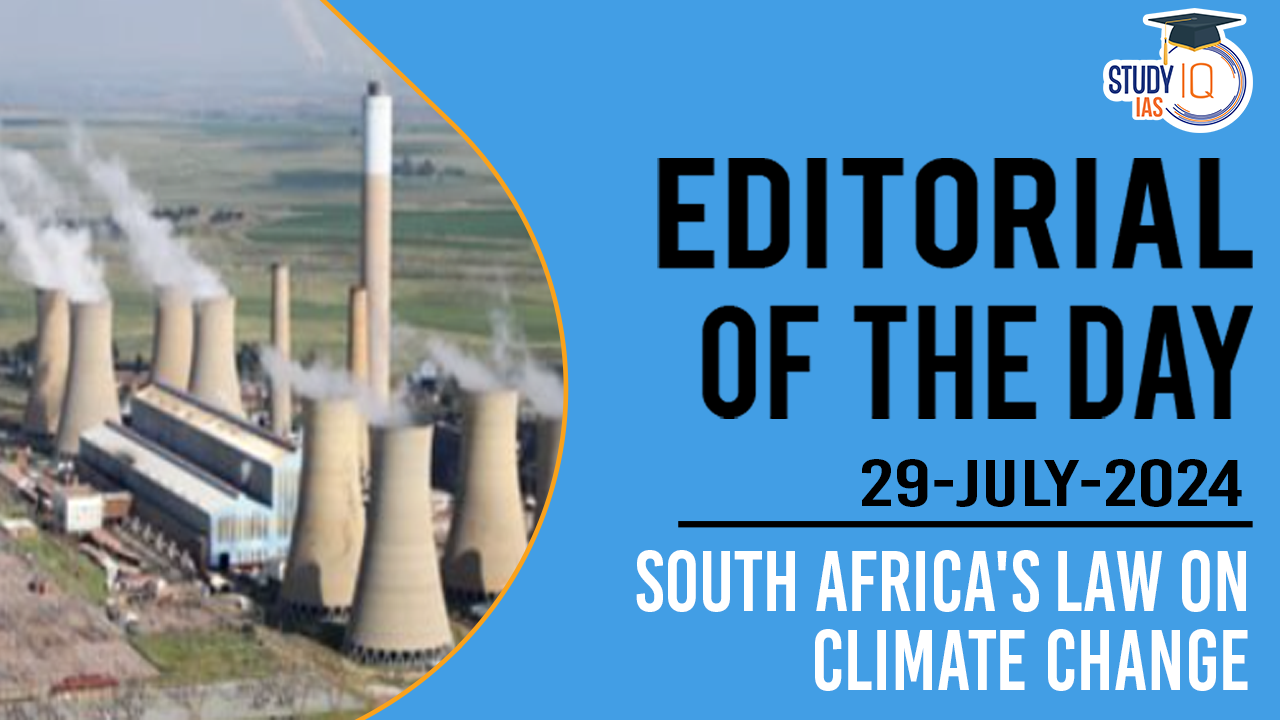Table of Contents
Context
- South Africa’s President, Cyril Ramaphosa, has signed legislation that imposes mandatory curbs on emissions from large, fossil-fuel-heavy industries and requires climate-adaptation plans from towns and villages.
- This law aims to help South Africa meet its emissions reduction commitments under the Paris Agreement.
Background
- The Climate Change Bill was approved by South Africa’s National Assembly in November.
- South Africa is highly reliant on coal for electricity generation and is among the world’s top 15 greenhouse gas emitters.
- In 2017, South Africa’s net emissions were estimated at 512 million tonnes of carbon dioxide equivalent (Mt CO2e), up 14% from 2000.
- By 2022, emissions had fallen to 405 Mt CO2e, a 3% decrease from 2021, according to Statista, though the comparability of these figures and the impact of the COVID-19 pandemic on emissions is unclear.
- The energy sector accounts for roughly 80% of gross emissions, with energy industries contributing ~60% and transport ~12%.
- As an economy dependent on agriculture and tourism, South Africa has faced increased pressure from Western nations to transition away from fossil fuels.
Steps Taken by South Africa
- Nationally Determined Contributions (NDC):
- South Africa submitted its first NDC in 2016 and an updated NDC in 2021.
- The updated NDC commits to a 31% reduction and sets a target for GHG emissions at 398-510 MtCO2e by 2025 and 350-420 MtCO2e by 2030.
- Approach to ‘Just Transition’:
- Focuses on sustainable job transitions away from fossil-fuel-dependent industries.
- Targets sectors such as agriculture, forestry, land use, energy, industrial processes, product use, and waste.
- Estimated funding needs of $8 billion per year by 2030.
- Aims for ‘net zero emissions’ by 2050 as per the Low-Emission Development Strategy submitted in 2020.
- Presidential Climate Commission’s Just Transition Framework (2022):
- Aims to inform policy making at the intersection of climate and development to enable significant, just transformational shifts.
Comparison with India
- India lacks comprehensive climate change legislation.
- Council on Climate Change Bill:
- A Private Member’s Bill moved by Priyanka Chaturvedi in 2022 proposed establishing a Council chaired by the Prime Minister to advise the Union government on climate change matters.
- No significant progress on this bill so far.
- Existing Laws:
- Climate change is addressed in multiple Acts, including the Environmental Protection Act, Forest Conservation Act, Energy Conservation Act, and Water (Prevention and Control of Pollution) Act.
Adequacy of Current Measures
- In April, the Supreme Court ruled that citizens have a “right against the adverse effects of climate change” and highlighted the absence of comprehensive climate change legislation.
- The Court emphasised that the impact of climate change impedes citizens’ rights to liberty, life, and equality, necessitating explicit legal links.
- Emissions Reduction Achievements:
- Before the UN Conference of Parties in Dubai, India reported a 33% reduction in energy emissions intensity from 2005-2019, achieving the target 11 years early.
- India’s updated NDC commits to reducing emissions intensity by 45% by 2030.
- Emission intensity measures GHG emissions per unit of GDP, differing from absolute emissions.
- India aims for 50% of its electricity to come from non-fossil fuel sources by 2030.


 Unlocking the Potential of India–Afric...
Unlocking the Potential of India–Afric...
 Speedy Justice and the Crisis in Consume...
Speedy Justice and the Crisis in Consume...
 Kavachi Volcano: Location, Features, Eru...
Kavachi Volcano: Location, Features, Eru...

























